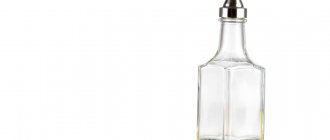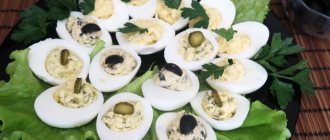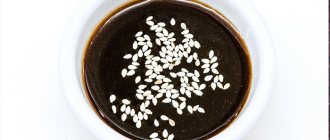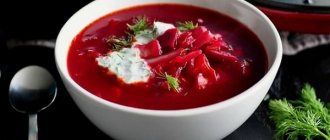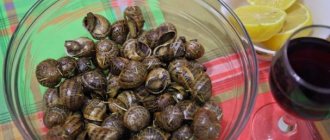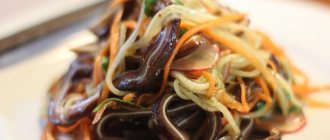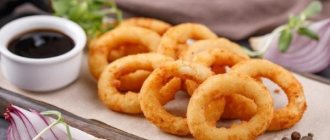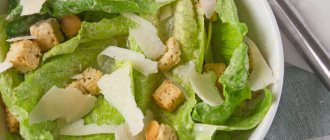Balsamic vinegar is one of the most expensive and refined seasonings. Its differences are a pleasant aroma, a sweet and sour taste, and a dark shade.
This type of food vinegar was invented in the Italian province of Modena back in the 11th century and was prepared exclusively from grape must. Now there are other cooking technologies, including lightweight and homemade ones.
Uses of balsamic vinegar in cooking
Nowadays, balsamic is used in expensive restaurants and private kitchens to add a spicy note to various dishes. It complements well the taste of seafood, vegetables, soups, chicken liver, cheeses, as well as fish, grilled meat, and omelettes. Italians always add it to spaghetti Bolognese, bruschetta, pizza, risotto, and various snacks.
In salads
Residents of Italy cannot imagine their life without such a simple salad as Caprese, the French - without Nicoise, and residents of the CIS and fans of a healthy lifestyle - without a refreshing beetroot salad. We'll tell you how to cook them.
"Caprese"
Ingredients:
- 400 g of Slivka tomatoes or similar varieties;
- 300 g mozzarella balls;
- 20 ml olive oil;
- 20 ml balsamic vinegar;
- 20 g fresh basil;
- pepper and salt (to taste).
Preparation:
- Cheese and tomatoes are cut into slices and, alternating, placed on a dish.
- Basil leaves are placed on top.
- Mix oil and vinegar and pour sauce over vegetables.
"Niçoise"
Ingredients:
- 1 can of canned tuna;
- 200 g cherry tomatoes;
- 100 g olives;
- 20 ml Dijon mustard;
- 80 ml olive oil;
- 100 g of lettuce;
- 7 quail eggs;
- 150 g fresh cucumber;
- 20 ml balsamic.
Preparation:
- The dishes are covered with lettuce leaves, the excess is torn into pieces by hand and set aside.
- Cut the olives, eggs and tomatoes into thick circles - into 2-4 parts lengthwise, and the cucumber - into strips.
- Vegetables are placed on a salad and sprinkled with oil.
- Place mashed canned food on top, sprinkle with olives and lettuce, and season with oil.
- Lay out slices of eggs and tomatoes.
- Whisk the balsamic vinegar, mustard and remaining olive oil and pour over the salad.
Fresh beet salad
Ingredients:
- 150 g beets;
- 200 g bell pepper;
- 20 g sesame seeds;
- 200 g fresh cucumber;
- 40 ml vegetable oil;
- 20 ml balsamic;
- 2 cloves of garlic;
- optional 2 cloves of garlic and a little soy sauce.
Preparation:
- The beets are grated, the remaining vegetables are cut into strips.
- Make a dressing from soy sauce, vinegar, olive oil and pour it over the vegetables.
- Before serving, sprinkle the salad with lightly fried sesame seeds in a dry frying pan.
Balsamic in hot dishes
Vinegar from wine must or wine emphasizes and highlights the taste of any meat or poultry. You can add cream, herbs, mustard, garlic, and spices to it.
Separately, it is used for marinating lamb and beef kebab. Any hot poultry or meat dish with balsamic will be very tasty if:
- Add vinegar only as a sauce or in the last minutes of frying/baking the product.
- Inject balsamic into the meat fibers with a syringe. This will soften the internal structure and give it a sweet and sour taste.
- Use the recipe with nuts.
- If you brush chicken, turkey, pork, etc. before putting it in the oven. balsamic vinegar, during baking a beautiful crust is formed.
Balsamic can also be used as a preservative for semi-finished meat products and canned food. It effectively fights germs and reduces the risk of infection.
An analogue of balsamic vinegar in Iran and the Caucasus is doshab - boiled, concentrated juice from fruits. In America, a similar seasoning is made from figs, black currants, coconut, and tangerines.
How to prepare salad dressings
Salad dressing with balsamic vinegar is quite common. At the same time, there are many options for preparing it. And each salad will have its own.
Making salad dressing with balsamic vinegar?
Not really
Which vinegar is better for salads: dark or light?
Dark, in comparison with light, is thicker. It is most often used for gas stations. However, light also has its advantages - aroma and softness. Therefore, in the question of which vinegar is best to use, you should focus only on your own tastes. Both are suitable for preparing salads.
Dressing with mustard
Dressing with mustard is called French. You can watch the recipe for its preparation in the video at the link:
Greek mustard dressing
The following ingredients are used to prepare the Greek salad dressing:
- olive oil - 200 ml;
- mustard - 2 tsp;
- lemon juice - 1 tsp;
- balsamic vinegar - 3 tsp;
- dry basil - 2 tsp.
Preparation:
- Mix all liquid ingredients together, then add basil.
Greek soy sauce dressing
To prepare this dressing, you just need to replace one ingredient - balsamic vinegar with soy sauce (2 tsp).
Dressing with honey
Dressing with honey is universal. It can be used for a variety of salads. You can get acquainted with the recipe for its preparation in the following video:
Wine vinegar dressing
Wine vinegar is also quite often used in dressings. It is this type that is best to replace balsamic if it is not available. At the same time, the taste characteristics change slightly. More tart notes and a different aroma of the final dish are acquired. The marinade for herring with vinegar, oil and onions is especially tasty.
Vegetable salad dressing
The advantage of vegetable salads is that a variety of dressings are suitable for them. You can use both mustard and honey. But the best option is the one that contains olive oil. It emphasizes the richness of the taste of vegetables and adds a number of its beneficial properties.
Olive oil dressing
Olive oil is a product that is very easy to use. It can be used separately from all the ingredients, as a stand-alone dressing. This option is especially suitable in cases where there is no time to prepare a sauce specifically for the salad.
Soy sauce dressing
Soy sauce is rarely used as a stand-alone dressing. It is best to use it in combination. It is also suitable as a substitute for balsamic vinegar in a recipe.
How to replace balsamic vinegar
At home and in restaurants, the gourmet thick, dark seasoning is usually replaced by:
- Brown rice vinegar. It is based on brown rice, hence the dark color.
- Chinese black vinegar. This is a cheaper option made from millet, sorghum or wheat, rice, which is added to French fries, marinades, sauces, and soups.
- Fruit, sherry or red wine vinegar with honey, sugar. It is suitable for salad dressings, marinades, and stewing.
See also: How to determine the quality of meat (beef, pork, lamb)
Composition of balsamic vinegar
Nutritional value per 100 grams of product
| Calorie content | 88 kcal |
| Squirrels | 0.49 g |
| Carbohydrates | 17.03 |
| Water | 76.45 g |
| Ash | 0.37 g |
? Macroelements per 100 grams of product
| Potassium, K | 112 mg |
| Calcium, Ca | 27 mg |
| Magnesium, Mg | 12 mg |
| Sodium, Na | 23 mg |
| Phosphorus, Ph | 19 mg |
Microelements per 100 grams of product
| Iron, Fe | 0.72 mg |
| Manganese, Mn | 0.131 mg |
| Copper, Cu | 26 mcg |
| Zinc, Zn | 0.08 mg |
Digestible carbohydrates per 100 grams of product
| Mono- and disaccharides (sugars) | 14.95 g |
| Glucose (dextrose) | 7.57 g |
| Fructose | 7.38 g |
All these indicators relate to classic, natural seasoning made from high-quality grape varieties.
Inexpensive substitutes can contain large amounts of sugar and a variety of chemical compounds.
3 homemade balsamic vinegar recipes
You won’t be able to get a 100% similar “sauce” at home. Housewives can only get closer to the basic taste characteristics. To do this, you will need to use similar ingredients and wait for the liquid to infuse under certain conditions.
Budget Recipe
You will need:
- 1 medium sized green apple;
- 3 sprigs of tarragon;
- 1 teaspoon of sugar and the same amount of white pepper;
- 0.5 l apple cider vinegar;
- 1 clove of garlic.
Cooking steps:
- Cut the apple into small slices and chop the tarragon.
- Divide a clove of garlic in half.
- All ingredients are placed in a glass jar and filled with 9% apple cider vinegar.
- Close the jar and place it in a cool, dark place for 14 days.
- The seasoning is filtered and then stored in the refrigerator.
Simple recipe
You will need:
- 200 ml wine vinegar;
- 50 g mixture of mint and tarragon.
Cooking steps:
- Mix herbs with vinegar in a glass container.
- Place in a dark place for 45 days.
- Keep in the refrigerator, shaking occasionally.
Classic recipe
You will need:
- 700 g fortified white wine;
- 2 small chili peppers;
- 70 ml vinegar essence;
- 20 g sugar;
- 2 sprigs of rosemary;
- 1 teaspoon of white pepper and the same amount of cinnamon.
Cooking steps:
- Prepare caramel from sugar in a frying pan.
- Pour in the wine, add the remaining ingredients and mix thoroughly until dissolved.
- Pour everything into a glass container and leave for 2 weeks in cool and dark.
- Strain and store in a dark, cool place.
What is the difference between balsamic vinegar and wine vinegar?
✅ Balsamic vinegar has soft acidity and a sweet fruity taste that saturates and makes the aroma of vegetable dishes and salads more intense.
It also perfectly shades and softens any type of meat and poultry. This is what distinguishes this high-quality seasoning made from freshly picked grapes.
The grape juice is boiled until a third of the volume remains, and then fermented in wooden barrels for 12 years. Over time it becomes sweeter and more concentrated. Inexpensive options are prepared from different types of vinegar and sweeteners.
To produce red wine vinegar, you need red wine, which is oxidized during fermentation. The product “ripens” for 12-24 months until it is fully prepared.
The less it is aged, the more sour it becomes. The result is a less sweet seasoning, but with a much more pronounced flavor. Red wine vinegar usually complements the spice bouquet.
Another difference is in the country of origin. Balsamic was invented in Italy, and wine vinegar in France.
Balsamic Vinegar Greek Salad Dressing Recipe
For a long time, the inhabitants of Hellas were unfamiliar with the seasoning from Italian Modena. But the age of globalization has done its job, and now the Greek salad “Khoryatiki”, that is, “Peasant”, has received a lot of variations. One of them concerns refueling:
- To make an authentic Greek salad dressing, mix 5-6 tablespoons of extra virgin olive oil with medium lemon juice.
- Add a pinch of oregano and thyme, and then thoroughly shake the dressing with a hand whisk or in a jar with a lid.
For a variation on this popular dish, we'll simply replace the lemon juice with two tablespoons of balsamic vinegar.
How to choose balsamic vinegar
The choice of this seasoning is large and in order to distinguish between the main characteristics, the European Union has introduced symbols. The label must certainly indicate when and where the product was produced and which of the three categories it belongs to.
See also: Apple cider vinegar - 5 simple recipes
Condimento
The quality of balsamic with such an inscription was not carefully controlled. It is unknown exactly how and where exactly it was made. The bottle may contain high-quality grape vinegar aged many years or tinted wine.
Cheap fakes contain a lot of sugar, and the list of ingredients of a good product includes grape must or grapes. Condimento is suitable for preparing salads and as one of the ingredients for dressing. You can’t make bruschetta or ice cream with it without evaporation.
IGP
This abbreviation refers to balsamic vinegar, which was produced and bottled in Modena. This is a mixture of wine vinegar and grape must. Depending on the country where the grapes grow, climate, transportation and storage conditions, the final properties, including taste, depend.
Vinegar with a subtler and more complex flavor will cost much more. The sweeter and thicker, the cheaper. Balsamic IGP can be used as an independent dressing for appetizers, vegetable salads, or an ingredient for risotto.
DOP
Traditional balsamic vinegar. Produced exclusively in Reggio Emilia or Modena. The wort pressed from certain grape varieties is used; no additional components are required. Another condition for being classified as traditional is that the aging period is more than 12 years.
The red label on the bottle indicates an aging period of 12 years, silver - 18, gold - 25. Over time, a thick texture, intense sweetness, and a “mirror-like” smooth surface appear. The type of barrel used gives additional shades: cherry, oak, ash, chestnut, etc. This vinegar is used to decorate assorted cheeses, and it is also used to prepare panna cotta.
Basic Salad Dressing Recipe with Balsamic Vinegar
Since the seasoning was invented in Modena, it is naturally most often used in Italian cuisine. It is believed that balsamic reveals the taste and aroma of products.
Therefore, salads are seasoned with this vinegar to highlight even the most neutral ingredient. Speaking of Italian cuisine, how can one not remember the appetizer with tomatoes and Mozzarella cheese?
These two ingredients are laid out in “scales” in a circle. To dress such a simple but very tasty salad, just add a few drops of balsamic vinegar to olive oil (necessarily first cold-pressed).
The proportions are one to three. Lightly stir and sprinkle the dressing over our tomato and mozzarella salad.
This dressing is also suitable for other simple snacks. You can sprinkle it on lettuce salad (especially Romaine). This sauce is prepared immediately before use.
✅ Benefits for the body
Balsamic vinegar is successfully used in folk medicine and cosmetology. It has a positive effect on various organs and systems.
Among the main functions:
- improvement of skin condition;
- support general immunity and aid in digestion;
- faster saturation and weight loss;
- reduction of arterial hypertension;
- prevention of blood clots and the development of vascular and heart diseases;
- decrease in blood sugar levels;
- blocking toxic cells and lowering cholesterol levels;
- wound healing;
- heartburn treatment;
- elimination of cellulite;
- prevention of cancer development;
- memory improvement;
- prevention of inflammation.
This product is not easy for pregnant women to use, but it is recommended in small quantities. It contains little salt, which distinguishes it from other dressings; in addition, it contains iron.
Balsamic is also used to make compresses for wounds and burns, after mixing it with a double portion of linseed, castor or olive oil. The mixture is applied to gauze, applied to the damaged area, covered with cotton wool and bandaged for about 5 hours. Make a cleansing face mask from high-quality vinegar: soak gauze with a small amount of undiluted product and apply for 15 minutes. Avoid lips and eyes. Then remove and after 60 minutes wash with a soft sponge, wipe the skin with ice.
If you have a sore throat, rinse your mouth with a solution consisting of 15 ml of balsamic, 200 ml of warm boiled water and 5 ml of honey. To rinse hair, vinegar is diluted in water (1:6) and used immediately.
Interesting facts about balsamic vinegar:
- Cleopatra prepared a love potion with balsamic vinegar.
- The creator of forensic medicine, Sun Tse, washed his hands with them, mixing in sulfur.
- In the 18th century, according to surviving documents, most diseases were treated thanks to this seasoning. In addition, it was she who allowed diabetics to reduce the amount of sugar until high-quality hypoglycemic drugs were invented.
Practical recommendations
Let us immediately warn you that you need to be able to choose this product correctly. To avoid purchasing a fake, never buy a product at a price significantly lower than the average. You should also avoid products packaged in plastic bottles.
The balsamic bite is not as sour as the wine bite. But it has far from a bland taste, so you can’t add too much of it. Just a few drops of this component can radically transform the finished dish and give it an exquisite touch. This component goes well with poultry, meat, eggs, vegetables, fruits, cheeses and seafood.
Typically, olive oil, sour cream, mustard or natural yogurt are added to salad dressings with balsamic vinegar. In addition, they are supplemented with herbs and aromatic spices. It is advisable to cut the components that make up such salads into large pieces. It is recommended to store ready-made snacks for no more than a few hours. It is better to serve them in deep porcelain containers.
